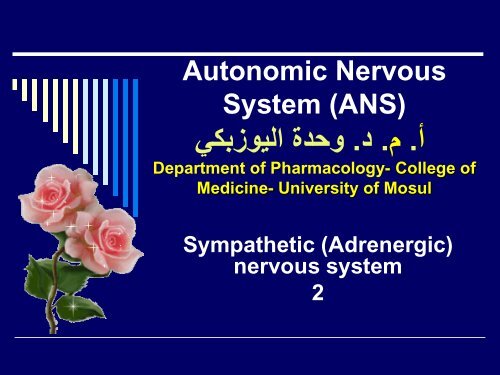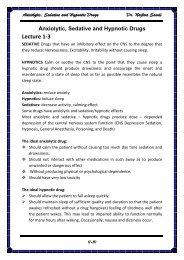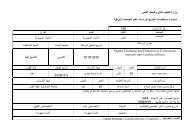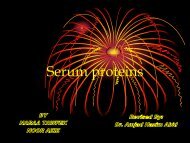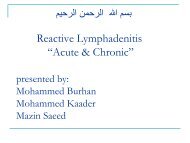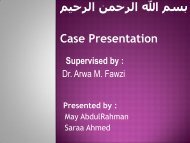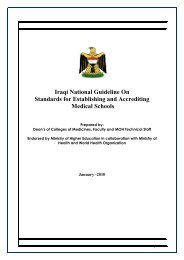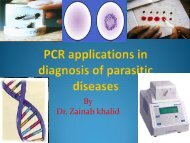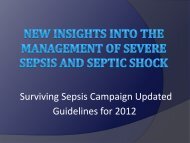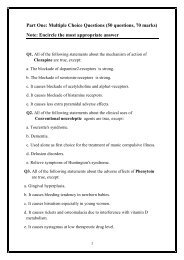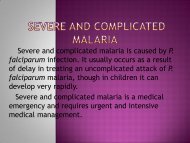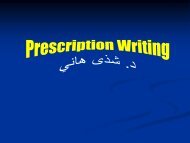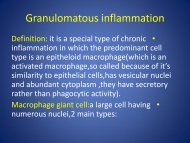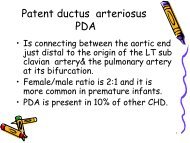Autonomic Nervous System (ANS)
Autonomic Nervous System (ANS)
Autonomic Nervous System (ANS)
You also want an ePaper? Increase the reach of your titles
YUMPU automatically turns print PDFs into web optimized ePapers that Google loves.
<strong>Autonomic</strong> <strong>Nervous</strong><br />
<strong>System</strong> (ANS)<br />
د. م. أ.<br />
وحدة اليوزبكي<br />
Department of Pharmacology- College of<br />
Medicine- University of Mosul<br />
Sympathetic (Adrenergic)<br />
nervous system<br />
2
Objectives<br />
At end of this lecture, the students will be able<br />
to:<br />
1- Enumerate the classes of Adrenergic Agonists<br />
drugs.<br />
2- List the most widely used group (Direct acting<br />
adrenergic agonists).<br />
3- Discuss the most clinically used drugs in the direct<br />
acting adrenergic agonists.<br />
In a way, consistence with standards scientific<br />
curriculum.
Classifications of Adrenergic Agonists according to<br />
mechanism of action
Classifications of According to mechanism<br />
of action<br />
I- Direct acting adrenergic agonists:<br />
Adrenaline (A), Noradrenaline (NA),<br />
Isoproterenol (isoprenaline), Dopamine,<br />
Phenylephrine, Methaxamine, Salbutamol,<br />
Terbutalin, Clonidine, Xylometazoline,<br />
Fenoldopam.
II- Indirect acting adrenergic agonists:<br />
1- Amphetamine.<br />
2- Tyramine.<br />
III- Mixed-action adrenergic agonists.<br />
1- Ephedrine.<br />
2- Metaraminol.
I- Direct acting adrenergic agonists<br />
(Sympathomimitics)<br />
- These bind to<br />
adrenergic<br />
(postsynaptic)<br />
receptors & causes<br />
intracellular signals &<br />
initiate action.<br />
- As a group these<br />
agents are widely used<br />
clinically.
I- Direct acting adrenergic agonists<br />
1- Epinephrine (Adrenaline) A:<br />
- Natural catecholamine, commonly used in<br />
therapy.<br />
- In therapeutic low doses : β R effect<br />
- At high dose : α R effect<br />
Biotransformation:<br />
C.A metabolized by COMT and MAO, and result in<br />
production of metanephrine & vanillyl-mandelic<br />
acid (VMA) in urine.<br />
Note:<br />
A destroyed by acid of stomach & so not effective<br />
orally & usually given SC or IM injection.<br />
-
Action of Adrenaline<br />
1- C.V.S:<br />
- Adrenaline causes increase HR & contraction of<br />
heart which lead to increase CO and so to<br />
increase systolic Bdp.<br />
- But Adrenaline cause decrease PR , which<br />
lead to slight decrease D Bdp.<br />
(Adrenaline Lead to increase systolic Bdp<br />
& Slight decrease D Bdp).
C.V.S effect of Adrenaline<br />
(Epinephrine)<br />
Summary:<br />
(Adrenaline Lead to<br />
increase systolic<br />
Bd p & Slight decrease<br />
diastolic Bdp).
2- Respiratory:<br />
Bronchodilatation (β 2).<br />
3-Metabolic:<br />
a- hyperglycemia by increase<br />
glycogenolysis in liver (β 2) & increase<br />
release of glucagon (β 2) + decrease<br />
release of insulin (α2).<br />
b- Lipolysis: due to agonist effect on β R<br />
of adipose tissue.
Clinical uses of Adrenaline<br />
1- Acute asthma.<br />
2- Anaphylactic shock<br />
hypersensitivity reaction).<br />
(1 st type<br />
3- Anesthesia:<br />
a- With LA (dilution of A 1:10000 parts), as A<br />
lead to increase duration of LA by<br />
vasoconstriction at the site of injection.<br />
b- Topically (topical haemostatic agent).<br />
4- Glaucoma (2% topically) due to decrease<br />
production of aqueous humor by<br />
vasoconstriction of ciliary body blood<br />
vessels.
Side effects of Adrenaline<br />
1- C.N.S: anxiety, fear, tension, headache,<br />
tremor.<br />
2- Hemorrhage: (due to increase cerebral<br />
Bd p)<br />
3- Cardiac dysarrhythmia: (with digoxin).<br />
- Large dose lead to V.fibrillation (may be<br />
fatal).<br />
4- Pulmonary oedema.
5- Drug interaction with Adrenaline<br />
a- Hyperthyroidism:<br />
Adrenaline lead to hypertensive response due to<br />
increase adrenergic R on vasculature of the<br />
hyperthyroid patients.<br />
b- Cocaine:<br />
Cocaine lead to increase CV response of adrenaline<br />
due to ability to prevent reuptake of C.A into<br />
adrenergic neurons.
2- Nor epinephrine (NE) (Levarterenol,<br />
(Nor adrenaline)<br />
- It is the chemical mediator librated by<br />
postganglionic sympathetic N.ending & act<br />
directly on the effector cells.<br />
- In therapeutic doses: α R effect and similar<br />
β1R effect (on heart) but no β 2 R.
Action of Nor adrenaline (NA)<br />
C.V.S :<br />
NA increase PR due to intensive vasoconstriction<br />
of most vascular bed<br />
( including kidney via α 1R), which lead to increase<br />
both S & D Bdp<br />
(with increase mean Bdp). This lead to<br />
compensatory vagal reflex by stimulation to the<br />
baroreceptor reflex , which cause decrease<br />
contraction of heart & decrease HR ( called reflex<br />
bradycardia).
C.V.S effect of Nor adrenaline<br />
Summary:<br />
NA cause intensive<br />
vasoconstriction<br />
which lead to<br />
increase PR, and so<br />
to:<br />
increase both S & D<br />
Bd pressure, and this<br />
lead to:<br />
reflex bradycardia<br />
(Nor epinephrine)
Notes:<br />
1- Due to powerful vasoconstrictor effect of<br />
NA:<br />
a- Lead to reflex bradycardia. -<br />
b- NA not used as vasoconstrictor in LA<br />
solution.<br />
-<br />
2- The main function of NA appear to be<br />
maintenance of normal sympathetic tone<br />
and adjustment of circulatory dynamic.
3- Isoproterenol (Isoprenoline):<br />
- Direct acting synthetic C.A.<br />
- It is extremely potent β R agonist (β 1,<br />
β 2).<br />
PK: Given sublingually, pranterally & as aerosol.<br />
Uses: Usually to stimulate heart in<br />
emergency<br />
cases.<br />
SE: as Adrenaline.
Action of Isoproterenol (Isoprenoline)<br />
1- C.V.S: (Like A)<br />
Lead to increase systolic Bdp & Slight<br />
decrease D Bd p).--- ?<br />
2- Pulmonary:<br />
β2R:Rapid & profound bronchodilatation.<br />
3- Other effects:<br />
- β R: increase Bd sugar & increase lipolysis<br />
(not significant clinically).
4- Dopamine<br />
-It is immediate metabolic precursor of N.A<br />
occurs naturally in C.N.S in basal ganglia<br />
(function as N.T) and in adrenal medulla.<br />
-<br />
- Dopamine activates:<br />
1- β1 Receptors (and at higher dose<br />
activate also a R.),<br />
2- D1 & D2 R occur in peripheral mesenteric<br />
& renal vascular bed lead to vasodilatation.
Actions of Dopamine<br />
1- C.V.S: Dopamine lead to increase force &<br />
rate of contraction of heart (β1 effect).<br />
2- Renal and visceral: Dilatation of renal &<br />
splanchnic arterioles (D1,D2 agonist effect),<br />
which lead to increase blood flow to kidney &<br />
other viscera.<br />
Uses:<br />
Dopamine drug of choice (over A) in shock as A<br />
cause decrease renal blood supply & may<br />
cause renal shutdown.<br />
Overdose:<br />
Nausea, hypertension, arrhythmia.
5- Fenoldopam<br />
D1 Receptor agonist: selectively cause<br />
peripheral arteriolar vasodilatation in<br />
vascular bed.<br />
-<br />
Uses: in severe hypertension (IV or<br />
continuous infusion).<br />
SE:<br />
Decrease K, tachycardia, headache,<br />
flushing.<br />
-


